Pea soup Recipe is more than just a simple meal—it’s a bowl full of warmth, tradition, and nourishment. Whether you’re craving a cozy dish on a cold evening, looking for a nutritious and filling meal, or seeking a recipe that’s easy to prepare in large batches, pea soup hits the mark. With its creamy texture, rich flavor, and endless customization options, it’s no surprise that pea soup has stood the test of time across cultures and generations.
At its core, pea soup is made from humble ingredients—dried or fresh peas, aromatic vegetables, herbs, and often a smoky or savory element like ham or bacon. What makes this dish truly special is its versatility.Whether you’re a meat lover, a vegetarian, or cooking for a gluten-free household, there’s a pea soup recipe for you.
This article is your ultimate guide to mastering the pea soup recipe from start to finish. We’ll explore its origins, health benefits, ingredient variations, cooking techniques, and smart serving suggestions. You’ll also learn how to adapt it for special diets, picky eaters, and even modern kitchen gadgets like the Instant Pot.
By the end, you’ll not only be ready to cook a soul-satisfying batch of pea soup but will also understand how to tailor it to your taste, nutritional needs, and lifestyle. Whether it’s your first time or your hundredth, this guide will take your soup-making game to the next level.
So, tie on your apron and grab a ladle—we’re diving into everything you need to know about making the perfect pea soup recipe at home.
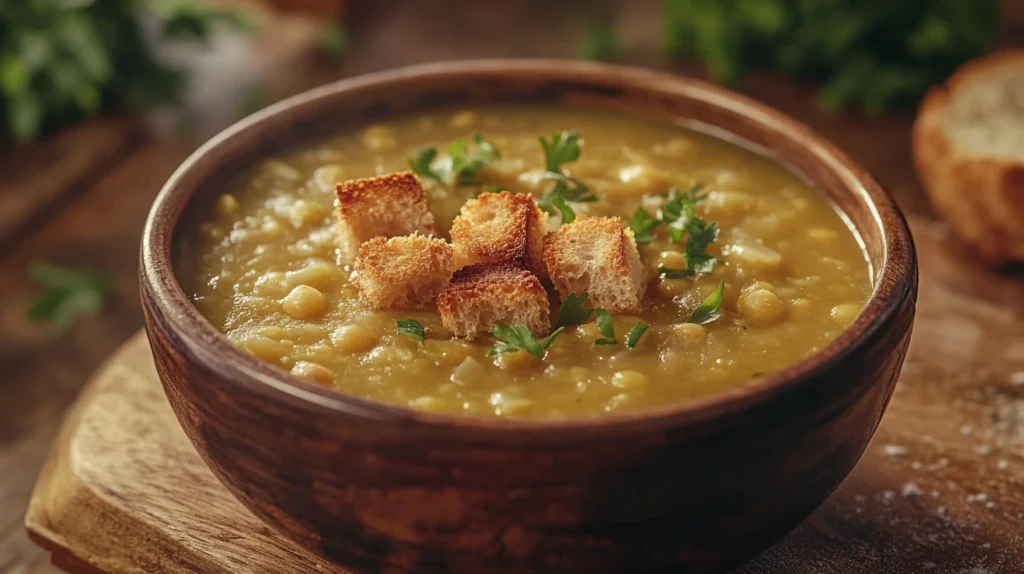
The Origins of Pea Soup
Historical Roots Across Cultures
With roots stretching back millennia, pea soup has long been a beloved dish.
Its humble ingredients and ease of preparation made it a staple in many ancient civilizations, particularly in Europe and the Middle East. In fact, the earliest versions of pea soup can be traced back to ancient Greece and Rome, where peas were often dried and cooked into stews or thick broths.
In Medieval Europe, especially in regions like Germany, England, and the Netherlands, dried peas were widely available and cheap. During the colder months, they were boiled into hearty soups with whatever vegetables or meats were available. Pea soup was not only nutritious and filling but also easy to make in large quantities—making it a common dish among peasants and soldiers alike.
In Nordic countries, “Ärtsoppa” (Swedish pea soup) remains a traditional dish served on Thursdays, often with mustard and accompanied by pancakes for dessert. This custom has been practiced for centuries, dating back to the early Catholic tradition of fasting on Fridays, with a hearty Thursday meal to prepare for it.
Evolution of Ingredients Over Time
The traditional pea soup recipe has evolved significantly, adapting to local tastes and available ingredients. In French cuisine, pea soup is usually transformed into a creamy, smooth purée and finished with cream. In the United States, particularly in the South and Midwest, ham bones or bacon are frequently added to give the soup a smoky depth of flavor.
As diets and health trends have changed, so too have the ingredients in pea soup. Modern versions include plant-based alternatives, low-sodium broths, and gluten-free thickeners. From rustic, chunky stews to smooth, sophisticated bisques, the core of the dish—peas—remains a universal constant, loved by millions for both taste and tradition.
For other globally inspired dishes, check out these flavorful Asian food recipes full of warming spices and nourishing broths.
Why Pea Soup is a Nutritional Powerhouse
Health Benefits of Peas
These small legumes are bursting with nutrition, rich in plant-based protein, dietary fiber, and essential vitamins and minerals. Just one cup of cooked split peas provides about 16 grams of protein and 16 grams of dietary fiber, making it one of the most satiating legumes you can eat.
Peas are also an excellent source of:
- Vitamin K, which supports bone health
- Folate, essential for cell function and tissue growth
- Manganese and iron, which play roles in metabolism and oxygen transport
- B vitamins, which aid in energy production
Thanks to this nutritional profile, pea soup can help regulate digestion, support heart health, and even aid in blood sugar control, especially when paired with other low-GI ingredients.
If you’re looking for healthy eating options that don’t skimp on flavor, you might also enjoy this Keto Breakfast Casserole, which is another nutrient-dense meal idea.
Other Key Nutritional Ingredients
What makes pea soup even more appealing is its ability to incorporate a variety of other healthy ingredients. Onions and garlic not only enhance flavor but also offer immune-boosting antioxidants. Carrots and celery provide beta-carotene, vitamin A, and additional fiber.
If you include bone broth or smoked meats, you get collagen and additional protein, but even the vegan versions remain nutrient-dense thanks to lentils, spinach, or other legumes that can be added for variety.
For those on a weight-loss journey, pea soup is a perfect fit: it’s low in fat, high in fiber, and incredibly filling, which helps curb cravings and maintain energy levels throughout the day.
Choosing the Right Peas
Split Peas vs. Fresh Green Peas
When it comes to making a great pea soup, choosing the right type of peas is crucial. The most commonly used variety is the split pea, which is a dried, peeled, and split seed of the Pisum sativum plant. These peas are available in two colors—green and yellow—and each brings a slightly different flavor and texture to the soup.
- Green split peas are sweeter and more commonly used in classic recipes.
- Their delicate taste makes yellow split peas a popular choice in Indian and Scandinavian kitchens alike.
Fresh green peas, on the other hand, give a brighter color and a lighter, more delicate flavor. However, they are not as starchy and don’t break down as easily into a thick soup unless puréed. If you’re aiming for a chunkier, rustic texture, go for split peas. For a fresh, vibrant summer version, fresh peas work beautifully, especially when blended.
Organic vs. Non-Organic Options
Grown naturally, organic peas are free from synthetic chemicals and genetic modification. While both organic and conventional peas are nutritious, organic peas may retain more natural flavor and nutrients, especially if you’re using them fresh. They’re also a better choice for those with sensitivities to chemicals or anyone following a clean-eating lifestyle.
That said, non-organic dried split peas are still highly nutritious and safe when rinsed properly. If you’re on a budget, there’s no need to worry—either option will produce a delicious soup.
Essential Ingredients for the Perfect Pea Soup Recipe
Core Ingredients
A traditional pea soup recipe starts with a few simple ingredients that, when combined, deliver incredible depth of flavor:
- Green or yellow split peas serve as the foundation of the dish. These provide thickness, protein, and that classic earthy taste.
- Aromatics (onion, garlic, celery, carrots) – These form the flavor base, also known as a mirepoix.
- Liquid (water, vegetable broth, or chicken broth) – The cooking medium that helps soften the peas and blend the flavors.
- Meat (optional) – Ham hocks, bacon, or smoked turkey can add a rich, smoky undertone.
- Bay leaf, thyme, salt, and black pepper – These herbs and spices elevate the flavor profile.
Depending on your taste and dietary needs, you can go meatless or choose lighter stocks, but these core elements are a great place to start.
Optional Add-ins for Flavor Variations
One of the best things about a pea soup recipe is how customizable it is. Here are a few additions to consider:
- Potatoes – Add creaminess and texture.
- Leeks – Offer a more delicate onion flavor.
- Smoked paprika or cumin – Add warmth and depth.
- Coconut milk – A vegan-friendly way to make the soup richer and creamier.
- Parmesan rind – A secret weapon for umami, especially in vegetarian versions.
- Fresh herbs – Parsley, dill, and mint can brighten up the finished dish.
By mixing and matching these ingredients, you can develop a flavor that’s uniquely your own, whether you’re looking for comfort food or an elegant starter.
For pairing ideas, this soup goes perfectly with something crisp like a green salad or something creamy like a Queso Blanco Dip.
Step-by-Step Guide to Making Traditional Pea Soup Recipe
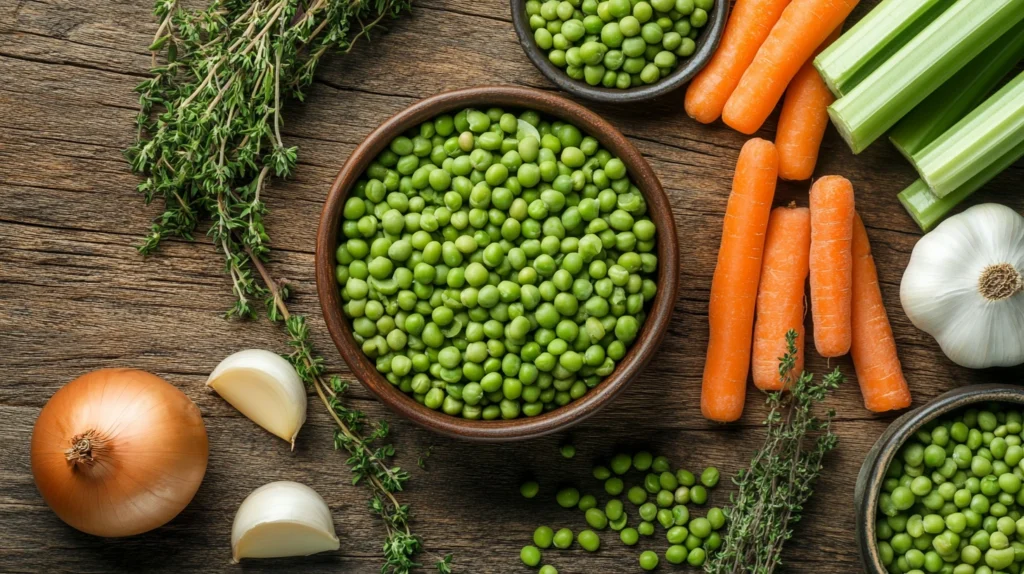
Prep Time, Cook Time & Serving Size
Before diving into the kitchen, let’s take a quick look at the general preparation overview:
- Prep Time: 15 minutes
- Cook Time: 1.5 to 2 hours (for stovetop); 40 minutes (for pressure cooker)
- Servings: 6-8
Made with green split peas, fresh vegetables, and a touch of ham if desired, this classic soup delivers comfort in every spoonful.
Cooking Instructions
Ingredients:
- 2 cups green split peas, cleaned and checked for debris
- 1 tablespoon olive oil or butter
- 1 medium onion, chopped
- 2 cloves garlic, minced
- 2 carrots, diced
- 2 celery stalks, diced
- 6 cups water or low-sodium broth
- 1 smoked ham hock or 1 cup diced cooked ham (optional)
- 1 bay leaf
- 1 teaspoon dried thyme
- Salt and black pepper to taste
Instructions:
- Begin by heating olive oil in a large soup pot over medium heat to sauté the vegetables. Add the onion, garlic, carrots, and celery. Sauté for approximately 5–7 minutes, until the veggies become tender and their aroma fills the kitchen.
- Pour in the broth or water, then add the split peas, thyme, and bay leaf, stirring well. Add the ham or ham hock if using.
- Heat until boiling, then immediately reduce the heat to low.
Cover and simmer for 1.5 to 2 hours, stirring occasionally to prevent sticking. - Pour in more water if the soup reduces too much or gets overly thick.
- When the peas reach a soft, creamy texture, remove the bay leaf from the pot. If using a ham hock, take it out, shred the meat, and return it to the pot.
- Blend (Optional): For a smoother texture, use an immersion blender to purée the soup slightly. Or leave it chunky—your choice!
- Season and Serve: Add salt and pepper to taste. Serve hot, garnished with croutons, herbs, or a swirl of cream if desired.
Tips to Avoid Common Mistakes
- Don’t skip rinsing the peas – This removes dirt and reduces the chance of bitterness.
- Avoid over-seasoning early – Salt can make peas tough if added too soon; wait until the end.
- Stir often – Peas can stick and burn on the bottom if left unattended.
- Too thick? Add more broth or water.
- Too thin? Simmer uncovered for a bit longer or mash some peas to thicken naturally.
Vegan and Vegetarian Pea Soup Recipe Variations
How to Substitute Meats or Dairy
If you’re skipping animal products, don’t worry—pea soup is incredibly easy to make vegan or vegetarian without sacrificing flavor.
Instead of ham, try one of these:
- Smoked paprika – Adds a deep smoky flavor reminiscent of bacon.
- Liquid smoke – Just a few drops can mimic that savory richness.
- Miso paste – Especially white or red miso, adds umami and depth.
- Plant-based sausage or tempeh – Slice and brown it before adding for texture and protein.
Ditch the dairy and use:
- Coconut cream – For a rich, silky finish and a light, sweet undertone.
- Cashew cream – Neutral in flavor and makes the soup velvety.
- Oat or almond milk – Lighter, but still gives a creamy mouthfeel.
Recommended Herbs and Spices for Vegans
Going meatless means the spices and herbs need to shine. Try adding:
- Turmeric – Brings color and wellness, thanks to its anti-inflammatory compounds.
- Cumin and coriander – Add an earthy, warming spice profile.
- Fresh parsley, mint, or basil – Stir in right before serving for a burst of freshness.
- Nutritional yeast – Imparts a cheesy essence without using any animal products.
These additions keep your vegan pea soup both hearty and exciting without compromising the wholesome goodness that makes this dish a classic.
Slow Cooker and Instant Pot Pea Soup Recipe
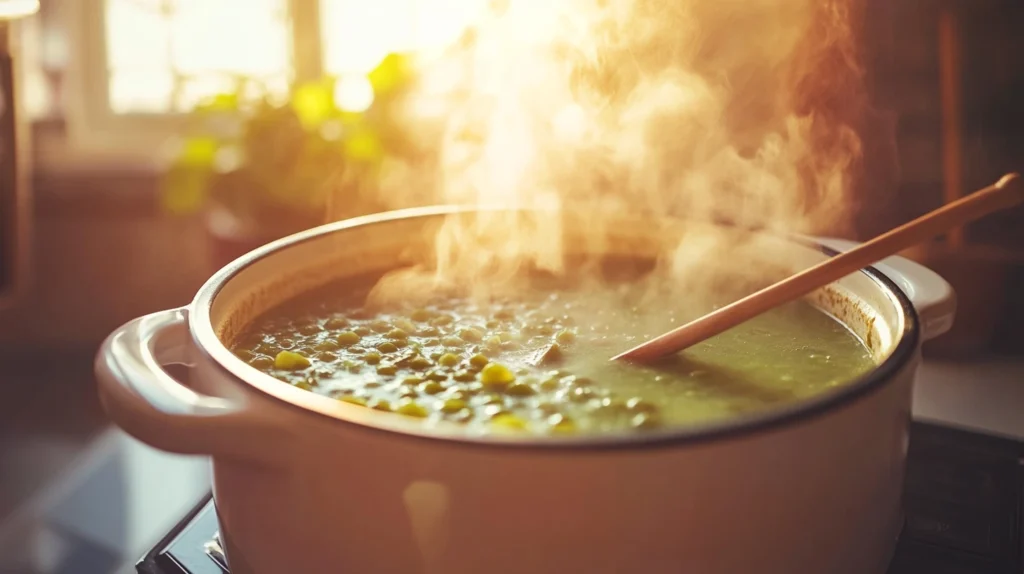
Adjustments in Cooking Time and Texture
Pea soup is a fantastic candidate for hands-off cooking methods like the slow cooker and Instant Pot, making it even easier for busy home cooks. These tools reduce active cooking time and yield consistent, rich results.
✅ Slow Cooker Version:
- Prep Time: 10–15 minutes
- Simmer in the slow cooker: 7–8 hours on low or 4–5 hours on high, depending on your schedule.
Instructions:
- Put the split peas, vegetables, broth, and seasonings together in the slow cooker bowl.
- If you’re using meat (like ham or a bone), add that too.
- Cover and cook on low for 7–8 hours. Peas should be soft and creamy.
- Remove bay leaf and blend slightly if desired.
- Season at the end with salt and pepper.
Pro Tip: For a chunkier texture, mash peas slightly with a wooden spoon. For creamy results, purée half with an immersion blender.
✅ Instant Pot Version:
- Prep Time: 10 minutes
- Cook Time: 15 minutes at high pressure + 10 minutes natural release
Instructions:
- Use the sauté function to cook onion, garlic, carrots, and celery in olive oil.
- Add peas, broth, herbs, and any meat you’re using.
- Cover with the lid, then set the cooker to high pressure and cook for 15 minutes.
- Let pressure release naturally for 10 minutes, then manually release the rest.
- Stir, blend if needed, and adjust seasoning.
Benefits of Using These Cooking Methods
- Time-saving: Especially with the Instant Pot, soup that normally simmers for hours is ready in under 30 minutes.
- Energy-efficient: No need to keep an eye on the stove.
- Enhanced flavor: Long, slow cooking deepens flavor, while pressure cooking locks it in.
- Batch-friendly: Both methods are great for cooking large portions, which you can freeze or meal prep.
Serving Suggestions and Pairings

Ideal Side Dishes and Breads
Pea soup is hearty enough to be a meal on its own, but pairing it with the right sides can elevate your table.
Top pairings include:
- Crusty bread or sourdough – Perfect for dipping into the thick soup.
- Grilled cheese sandwiches – Especially with cheddar or Swiss.
- Garlic bread or focaccia – Add flavor and texture.
- Simple green salad – Light and crisp to balance the soup’s richness.
- Pickles or pickled onions – A tangy contrast to the creamy base.
You can also serve it as a starter course in a multi-course meal, especially during the colder months.
Garnishes and Presentation Tips
A good garnish not only adds visual appeal but also flavor and texture. Try topping your pea soup with:
- A drizzle of olive oil or coconut cream
- Fresh chopped herbs (parsley, dill, or mint)
- Toasted croutons or crispy bacon bits
- Grated parmesan or nutritional yeast
- Incorporate lemon zest or a splash of vinegar to enhance freshness and balance.
For presentation, serve in a wide, shallow bowl with a colorful garnish in the center. Contrast your garnish color with the soup’s green to make it pop!
Whether it’s for a weeknight dinner or a dinner party, a thoughtfully served bowl of pea soup can feel gourmet, even if it’s made with pantry staples.
Storage and Reheating Tips
How to Store for Freshness
Pea soup stores exceptionally well, making it ideal for meal prep and leftovers. Store it properly by following these tips to lock in flavor and freshness:
- To refrigerate: Cool the soup first, then seal in airtight containers and keep refrigerated for a maximum of 5 days.
- Avoid metal containers for storage, as they can affect taste over time.
- Stir well before serving, as the soup will thicken in the fridge.
Freezing Instructions and Shelf Life
Pea soup freezes beautifully, so go ahead and make a double batch! Here’s how:
- Cool completely before freezing.
- Divide into individual portions in freezer-safe containers or resealable bags.
- Be sure to date the container, then freeze for up to 3 months of storage.
To reheat:
- Stovetop: Reheat over low heat, adding a splash of water or broth to loosen the texture.
- Microwave: Heat in 1-minute intervals, stirring in between for even heating.
Pea Soup Recipe for Kids and Picky Eaters
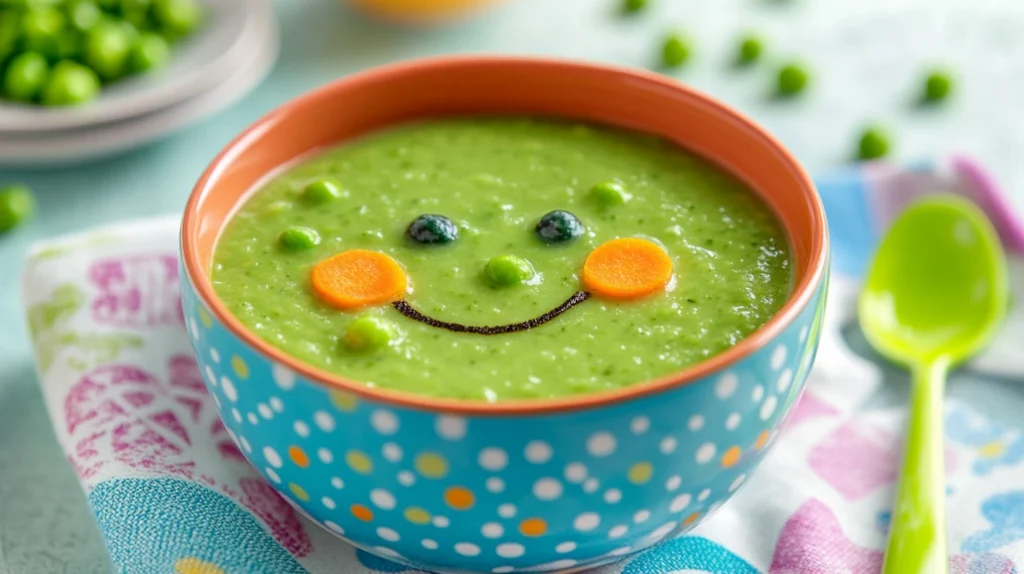
Fun Presentation Ideas for Children
Getting kids to eat vegetables can be tricky, but with the right approach, pea soup becomes a hit!
- Brighten up the bowl with fun crouton shapes or kid-friendly grilled cheese minis.
- Use a smiley face garnish made of sour cream, peas, or diced veggies.
- Add a swirl of bright orange carrot purée for a colorful touch.
- Let kids choose their own toppings—like grated cheese or crunchy tortilla strips.
Nutritional Adjustments for Young Eaters
- Lower the sodium for toddlers by using no-salt-added broth.
- Balance the flavors with added carrots or sweet potatoes for a subtle, sweet boost.
- Blend the soup until very smooth to avoid visible “green bits.”
These small tweaks make the dish more appealing to young palates without losing any nutritional value.
Gluten-Free and Allergy-Friendly Adaptations
Alternatives to Traditional Thickeners
Pea soup naturally thickens as it cooks, so no flour or cream is needed. But if you want to enhance its creaminess without allergens, consider:
- Mashed potatoes or sweet potatoes
- Unsweetened coconut milk or oat milk
- Blended carrots or cauliflower
These are all gluten-free and safe for most diets.
Avoiding Common Allergens
To make your pea soup allergy-friendly:
- Skip dairy and nuts – Use plant-based creamers that are nut-free.
- No garlic or onion? Use leek greens or celery root for similar flavor.
- Avoid gluten – Stick with natural thickeners and check your broth ingredients.
This flexibility makes pea soup a welcoming dish for nearly everyone at the table.
Frequently Asked Questions
What are the ingredients for pea soup?
A classic pea soup recipe typically includes:
- Green split peas (or yellow)
- Vegetables: onions, carrots, celery, and garlic
- Broth or water
- Seasonings: bay leaf, thyme, salt, and pepper
- Optional meat: ham bone, bacon, or diced ham
- Olive oil or butter for sautéing
You can also add potatoes, leeks, or herbs like parsley and dill for more depth of flavor.
What is the difference between split pea soup and pea soup?
The variation mainly depends on which peas are chosen for the soup:
- Split pea soup uses dried, split peas—typically green or yellow—that break down as they cook, giving the soup a thick, hearty texture.
- Pea soup may refer more broadly to any soup made with peas, including fresh green peas, which tend to result in a lighter, brighter soup often blended for smoothness.
Split pea soup is thicker and more rustic, while pea soup using fresh peas is often creamier and lighter in flavor.
What to add to pea soup for flavor?
You can boost the flavor of your pea soup with these tasty add-ins:
- Smoked meats: ham hock, bacon, smoked turkey
- Spices: cumin, smoked paprika, turmeric
- Herbs: thyme, bay leaf, parsley, mint
- Umami enhancers: miso paste, Parmesan rind, nutritional yeast
- Aromatics: sautéed onions, garlic, and leeks
For a tangy twist, a splash of lemon juice or vinegar added just before serving can brighten up the flavor.
How to make French Canadian pea soup?
French Canadian pea soup (Soupe aux pois) is a traditional dish often made with yellow split peas, pork hock, and root vegetables. Here’s a simplified version:
Ingredients:
- 2 cups yellow split peas
- 1 smoked pork hock or salt pork
- 1 onion, chopped
- 2 carrots, diced
- 2 celery stalks, diced
- 1 bay leaf
- 8 cups water
- Salt and pepper to taste
Instructions:
- Rinse split peas and place in a pot with pork and water.
- Boil briefly, then lower the heat and maintain a gentle simmer.
- Add chopped vegetables and bay leaf after 30 minutes.
- Simmer for 1.5 to 2 hours until peas and meat are tender.
- Shred meat, return to pot, and season to taste.
It’s a hearty and historic Canadian classic!
How healthy is pea soup for you?
Pea soup is incredibly healthy and nutrient-dense. It’s high in:
- Plant-based protein (about 16g per cup of split peas)
- Dietary fiber, which supports digestion and heart health
- Vitamins and minerals like folate, iron, magnesium, and vitamin K
It’s naturally low in fat, keeps you full longer, and is ideal for weight management, blood sugar control, and gut health. Just be mindful of sodium if using commercial broths or cured meats.
What thickens pea soup?
Pea soup thickens naturally as the peas cook and break down. However, you can thicken it further by:
- Simmering uncovered to reduce liquid
- Blending a portion with an immersion blender
- Adding potatoes or starchy vegetables
- Stirring in mashed peas
- For creaminess, use a splash of coconut milk or cashew cream in vegan versions.
No flour or cornstarch needed—peas do the job beautifully!
Conclusion
The beauty of the Pea Soup Recipe lies in its simplicity, nutrition, and adaptability. Whether you’re going traditional with ham and vegetables, experimenting with vegan ingredients, or using your Instant Pot for a quick fix, there’s a version of this dish for every lifestyle and taste.
It’s one of those rare meals that’s both comforting and nourishing, and its history across cultures is a testament to how timeless and loved it truly is. Make it thick or smooth, meaty or vegan, spicy or mild—the choice is yours. With just a few ingredients and a little love, you’ll have a bowl of something warm, satisfying, and utterly delicious.
So, go ahead—gather your ingredients and make your own version of this classic dish. Once you taste that first spoonful, you’ll know why pea soup remains a beloved staple in kitchens around the world.
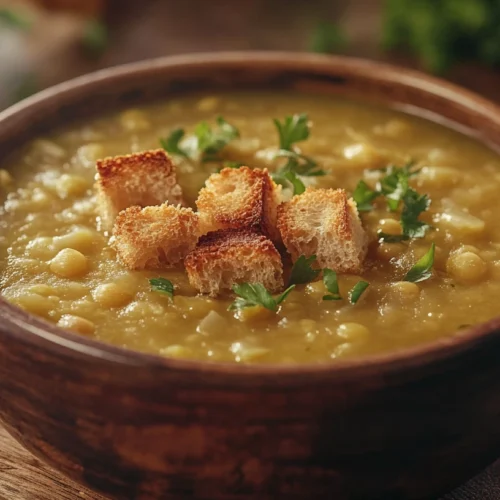
Classic Homemade Pea Soup Recipe
Equipment
- Large soup pot or Dutch oven
- Wooden spoon
- Chef’s knife and cutting board
- Ladle
- Measuring cups and spoons
- (Optional) Slow cooker or Instant Pot
- (Optional) Immersion blender or stand blender
Ingredients
- Base Ingredients:
- 2 cups green split peas rinsed
- 1 tbsp olive oil or butter
- 1 medium onion chopped
- 2 carrots diced
- 2 celery stalks diced
- 2 garlic cloves minced
- 6 cups low-sodium vegetable or chicken broth
- 1 bay leaf
- 1 tsp dried thyme
- Salt and pepper to taste
- Optional:
- 1 smoked ham hock or 1 cup diced cooked ham omit for vegan/vegetarian
- 1 small potato diced (for extra creaminess)
- Fresh parsley for garnish
Instructions
- Sauté the vegetables:
- In a large soup pot, heat the olive oil over medium heat. Add chopped onion, carrots, celery, and garlic. Sauté for 5–7 minutes until soft and fragrant.
- Add peas and seasonings:
- Stir in the rinsed split peas, broth, bay leaf, and thyme. Add the ham hock or diced ham if using.
- Simmer the soup:
- Bring to a boil, then reduce heat and simmer covered for 1.5 to 2 hours, stirring occasionally. Peas should be tender and starting to break down.
- Remove and blend (optional):
- Remove the bay leaf. For a smoother texture, blend part of the soup using an immersion blender or regular blender.
- Final season & serve:
- Add salt and pepper to taste. Remove the ham hock if used, shred the meat, and return to the pot. Ladle into bowls and garnish with parsley.

